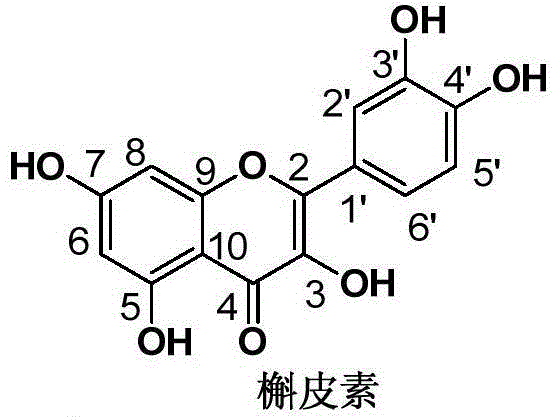Method for extracting quercetin from eleocharis tuberosa peels
A technique for water chestnut bark and quercetin, which is applied in the field of extraction and separation of quercetin, and the extraction and separation of quercetin from water chestnut bark, can solve unseen problems, and achieves low production cost, good separation effect, and easy availability of raw materials. Effect
- Summary
- Abstract
- Description
- Claims
- Application Information
AI Technical Summary
Problems solved by technology
Method used
Image
Examples
Embodiment 1
[0025] Add 8kg of fresh water chestnut skin powder into the extraction tank, add 32L of 70% by volume acetone aqueous solution, soak at 25°C for 24 hours, soak for 3 times in total, filter, combine the filtrates, concentrate under reduced pressure to obtain 1.05kg of extract .
[0026] The extract was added to 5.0 L of water to make a turbid liquid, extracted three times with 5.0 L of ethyl acetate, the extracts were combined and concentrated under reduced pressure to obtain 120 g of the extract.
[0027] Add 300mL methanol to the extract to dissolve, mix the sample with 260g polyamide, volatilize the methanol to dryness, install the column, connect to the MCI column for medium pressure separation, use 40-100% by volume methanol aqueous solution as the mobile phase gradient elution, Collected in 500 mL portions, detected by thin-layer chromatography, collected the eluent with a combined mobile phase concentration of 65-69%, concentrated under reduced pressure to obtain 9.8 g o...
Embodiment 2
[0032] Add 8kg of fresh water chestnut skin powder into the extraction tank, add 32L of 70% by volume acetone aqueous solution, soak at 25°C for 24 hours, soak for 3 times in total, filter, combine the filtrates, concentrate under reduced pressure to obtain 1.05kg of extract .
[0033] The extract was added to 5.0 L of water to make a turbid liquid, extracted three times with 5.0 L of ethyl acetate, the extracts were combined and concentrated under reduced pressure to obtain 120 g of the extract.
[0034] Add 300mL methanol to the extract to dissolve, mix the sample with 260g polyamide, volatilize the methanol to dryness, install the column, connect to the MCI column for medium pressure separation, use 40-100% by volume methanol aqueous solution as the mobile phase gradient elution, Collected in 500 mL portions, detected by thin-layer chromatography, collected the eluent with a combined mobile phase concentration of 65-69%, concentrated under reduced pressure to obtain 9.8 g o...
Embodiment 3
[0039] Add 8kg of fresh water chestnut skin powder into the extraction tank, add 32L of 70% by volume acetone aqueous solution, soak at 25°C for 24 hours, soak for 3 times in total, filter, combine the filtrates, concentrate under reduced pressure to obtain 1.05kg of extract .
[0040] The extract was added to 5.0 L of water to make a cloudy liquid, extracted three times with 5.0 L of ethyl acetate, the combined extracts were concentrated under reduced pressure to obtain 120 g of the extract.
[0041] Add 300mL methanol to the extract to dissolve, mix the sample with 260g polyamide, volatilize the methanol to dryness, install the column, connect to the MCI column for medium pressure separation, use 40-100% volume percent methanol aqueous solution as the mobile phase gradient elution, Collected in 500 mL portions, detected by thin-layer chromatography, collected the eluent with a combined mobile phase concentration of 65-69%, concentrated under reduced pressure to obtain 9.8 g ...
PUM
 Login to View More
Login to View More Abstract
Description
Claims
Application Information
 Login to View More
Login to View More - R&D
- Intellectual Property
- Life Sciences
- Materials
- Tech Scout
- Unparalleled Data Quality
- Higher Quality Content
- 60% Fewer Hallucinations
Browse by: Latest US Patents, China's latest patents, Technical Efficacy Thesaurus, Application Domain, Technology Topic, Popular Technical Reports.
© 2025 PatSnap. All rights reserved.Legal|Privacy policy|Modern Slavery Act Transparency Statement|Sitemap|About US| Contact US: help@patsnap.com

